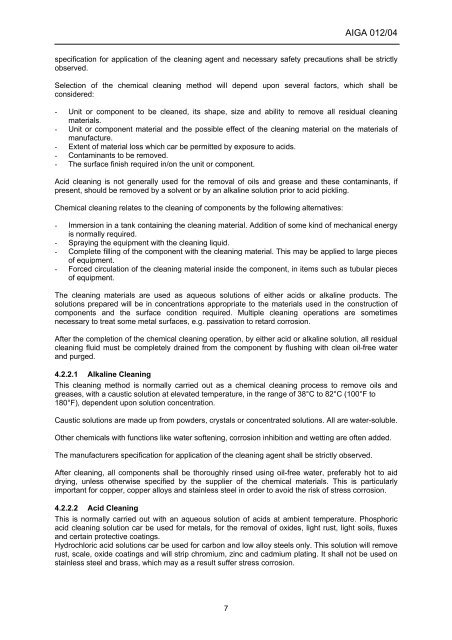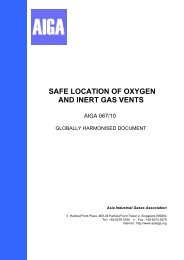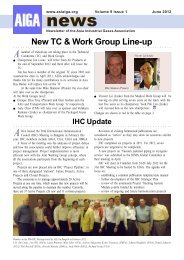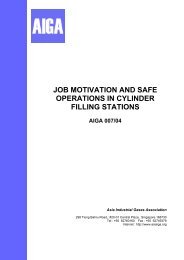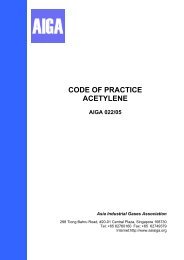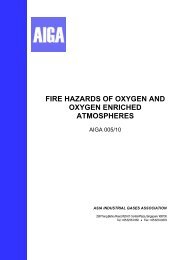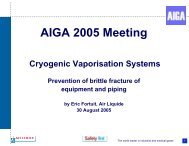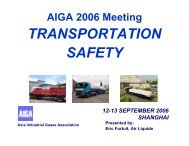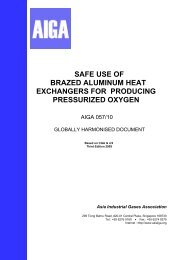CLEANING OF EQUIPMENT FOR OXYGEN SERVICE - AIGA
CLEANING OF EQUIPMENT FOR OXYGEN SERVICE - AIGA
CLEANING OF EQUIPMENT FOR OXYGEN SERVICE - AIGA
Create successful ePaper yourself
Turn your PDF publications into a flip-book with our unique Google optimized e-Paper software.
7<br />
<strong>AIGA</strong> 012/04<br />
specification for application of the cleaning agent and necessary safety precautions shall be strictly<br />
observed.<br />
Selection of the chemical cleaning method will depend upon several factors, which shall be<br />
considered:<br />
- Unit or component to be cleaned, its shape, size and ability to remove all residual cleaning<br />
materials.<br />
- Unit or component material and the possible effect of the cleaning material on the materials of<br />
manufacture.<br />
- Extent of material loss which car be permitted by exposure to acids.<br />
- Contaminants to be removed.<br />
- The surface finish required in/on the unit or component.<br />
Acid cleaning is not generally used for the removal of oils and grease and these contaminants, if<br />
present, should be removed by a solvent or by an alkaline solution prior to acid pickling.<br />
Chemical cleaning relates to the cleaning of components by the following alternatives:<br />
- Immersion in a tank containing the cleaning material. Addition of some kind of mechanical energy<br />
is normally required.<br />
- Spraying the equipment with the cleaning liquid.<br />
- Complete filling of the component with the cleaning material. This may be applied to large pieces<br />
of equipment.<br />
- Forced circulation of the cleaning material inside the component, in items such as tubular pieces<br />
of equipment.<br />
The cleaning materials are used as aqueous solutions of either acids or alkaline products. The<br />
solutions prepared will be in concentrations appropriate to the materials used in the construction of<br />
components and the surface condition required. Multiple cleaning operations are sometimes<br />
necessary to treat some metal surfaces, e.g. passivation to retard corrosion.<br />
After the completion of the chemical cleaning operation, by either acid or alkaline solution, all residual<br />
cleaning fluid must be completely drained from the component by flushing with clean oil-free water<br />
and purged.<br />
4.2.2.1 Alkaline Cleaning<br />
This cleaning method is normally carried out as a chemical cleaning process to remove oils and<br />
greases, with a caustic solution at elevated temperature, in the range of 38°C to 82°C (100°F to<br />
180°F), dependent upon solution concentration.<br />
Caustic solutions are made up from powders, crystals or concentrated solutions. All are water-soluble.<br />
Other chemicals with functions like water softening, corrosion inhibition and wetting are often added.<br />
The manufacturers specification for application of the cleaning agent shall be strictly observed.<br />
After cleaning, all components shall be thoroughly rinsed using oil-free water, preferably hot to aid<br />
drying, unless otherwise specified by the supplier of the chemical materials. This is particularly<br />
important for copper, copper alloys and stainless steel in order to avoid the risk of stress corrosion.<br />
4.2.2.2 Acid Cleaning<br />
This is normally carried out with an aqueous solution of acids at ambient temperature. Phosphoric<br />
acid cleaning solution car be used for metals, for the removal of oxides, light rust, light soils, fluxes<br />
and certain protective coatings.<br />
Hydrochloric acid solutions car be used for carbon and low alloy steels only. This solution will remove<br />
rust, scale, oxide coatings and will strip chromium, zinc and cadmium plating. It shall not be used on<br />
stainless steel and brass, which may as a result suffer stress corrosion.


